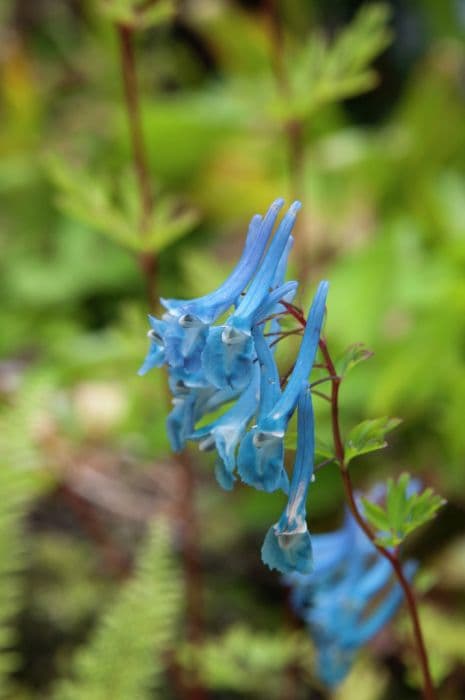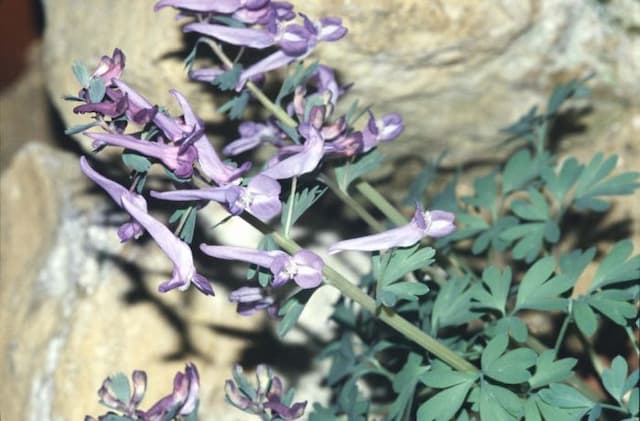Himalayan Blue Poppy Meconopsis betonicifolia Franch.

ABOUT
Known commonly as Himalayan blue poppy, this plant is a captivating beauty predominantly known for its strikingly vivid blue flowers, which are a rarity amongst floral species. The poppy showcases large, silky, cup-shaped blooms that typically display a gorgeous deep blue hue, sometimes with a purple tint. At the center of each flower, there's a cluster of golden-yellow stamens that create a striking contrast against the blue petals. The plant itself has a rosette of hairy leaves at its base, which are green in color and may have a slightly bluish tinge. The leaves are oblong shaped and can have a slight tooth to their edges, providing a lush backdrop for the jewel-like flowers atop. The Himalayan blue poppy thrives in cooler environments and is often found in alpine regions where the temperatures are moderate. It has a preference for moist, well-drained soils and usually requires a shady position to protect its delicate blossoms from the harsh direct sunlight. The perennial nature of this plant means that with the right conditions it can return year after year, gracing gardens with its unique and striking flowers.
About this plant
 Names
NamesFamily
Papaveraceae
Synonyms
Tibetan Blue Poppy, Himalayan Blue Poppy, Tibetan Poppy, Himalayan Poppy, Blue Poppy
Common names
Meconopsis baileyi H. R. Fletcher & Kingdon Ward, Papaver betonicifolium (Franch.) Voss.
 Toxicity
ToxicityTo humans
The Himalayan blue poppy is generally not considered toxic to humans. There are no well-documented cases of poisoning or adverse reactions from touching or ingesting this plant. However, as with any plant, individual allergies or sensitivities may exist, so it is always prudent to exercise caution and not consume parts of plants that are not typically recognized as food.
To pets
The Himalayan blue poppy is not commonly known to be toxic to pets such as dogs and cats. There is a lack of specific information on its toxicity to animals, but it does not appear on lists of commonly recognized poisonous plants for pets. Nevertheless, it's always wise to prevent pets from ingesting plants or plant material that is not meant for consumption, as individual reactions can vary and gastrointestinal upset is possible if a pet eats a significant quantity.
 Characteristics
CharacteristicsLife cycle
Perennials
Foliage type
Deciduous
Color of leaves
Green
Flower color
Blue
Height
3 feet (90 cm)
Spread
1 foot (30 cm)
Plant type
Herb
Hardiness zones
5
Native area
Tibet
Benefits
 General Benefits
General Benefits- Ornamental Value: Known as Himalayan Blue Poppy, it is highly prized in gardens for its striking blue flowers, which add a unique pop of color to the landscape.
- Biodiversity Support: It provides habitat and food for a variety of insects, including bees and butterflies, which are crucial for pollination.
- Educational Interest: It is of interest to botanists and gardening enthusiasts who are fascinated by its rare color and the challenges it presents in cultivation.
- Cultural Significance: In its native regions, it may hold cultural importance and be featured in local traditions and artwork.
 Medical Properties
Medical PropertiesThis plant is not used for medical purposes.
 Air-purifying Qualities
Air-purifying QualitiesThis plant is not specifically known for air purifying qualities.
 Other Uses
Other Uses- Himalayan Blue Poppy's (Meconopsis betonicifolia) seeds can be used to produce a blue dye; although not commonly employed, the potential exists for small-scale natural dye production.
- The wool industry could use the dye from the Himalayan Blue Poppy to color yarns in a similar fashion to other natural dyes, giving textiles a unique hue.
- Its striking flowers make it an ideal candidate for ornamental use in gardens themed around blue and cool-colored flowers, creating aesthetic landscape designs.
- The plant can be used in educational settings to teach botanical illustration and plant morphology due to its intricate and detailed structure.
- Himalayan Blue Poppy is suitable for alpine and rock gardens, as it naturally grows in mountainous habitats, providing authenticity to such garden designs.
- Due to its rarity and distinctive appearance, it can be cultivated for plant competitions and horticultural shows, where unique species are often featured.
- The visual appeal of the Himalayan Blue Poppy can be utilized in art installations and public gardens to attract visitors and enhance the viewing experience.
- In photography, the Himalayan Blue Poppy provides a vibrant subject for botanical and nature photographers aiming to capture the beauty of unique plant species.
- The plant can be integrated into mindfulness and therapeutic garden spaces, where its calming color and rarity can contribute to a peaceful and meditative atmosphere.
- Himalayan Blue Poppy could play a role in conservation efforts as a flagship species, drawing attention to the importance of preserving plant diversity and unique ecosystems.
Interesting Facts
 Feng Shui
Feng ShuiThe Blue Poppy is not used in Feng Shui practice.
 Zodiac Sign Compitability
Zodiac Sign CompitabilityThe Blue Poppy is not used in astrology practice.
 Plant Symbolism
Plant Symbolism- Peace and Tranquility: The Meconopsis betonicifolia, commonly known as Himalayan Blue Poppy, is often associated with a serene and tranquil state, largely due to its calming blue hue that is reminiscent of clear skies and peaceful waters.
- Resilience and Survival: Given its natural habitat in the harsh mountainous regions of the Himalayas, the blue poppy symbolizes the ability to thrive in challenging conditions and the courage to face adversity.
- Rarity and Unique Beauty: The distinct blue color of its petals makes the Himalayan Blue Poppy a symbol for uniqueness and extraordinary beauty. Its rarity in nature also contributes to its association with special and unique occurrences.
- Dreams and Aspirations: The ephemeral and almost magical appearance of the blue poppy's blooms has led it to be a symbol for aspiring to achieve the unattainable or to pursue one's dreams despite obstacles.
 Water
WaterThe Himalayan Blue Poppy, or Meconopsis betonicifolia, thrives best with regular watering that keeps the soil consistently moist but not waterlogged. During its growing season, water the plant thoroughly once a week with approximately half a gallon per plant, ensuring you're moistening the soil to a depth of at least 4 inches. Adjustments may be needed depending on climate and weather conditions; in hotter, drier periods more frequent watering may be necessary. In the winter, reduce watering to prevent root rot but do not let the soil completely dry out.
 Light
LightThe Himalayan Blue Poppy prefers dappled sunlight or light to moderate shade conditions. It thrives in an environment where it can be shielded from the direct harsh afternoon sun, which can scorch its delicate foliage and flowers. A spot that receives morning sun followed by afternoon shade or filtered light through a canopy of trees is ideal for the growth of this plant.
 Temperature
TemperatureFor the Himalayan Blue Poppy, the ideal temperature range is from 50 to 60 degrees Fahrenheit. It can tolerate a minimum temperature down to around 32 degrees Fahrenheit, making it suitable for cooler climates, and it can survive maximum temperatures up to about 75 degrees Fahrenheit. Overall, cooler temperatures especially during the night are preferred for this alpine plant.
 Pruning
PruningPruning the Himalayan Blue Poppy is mostly about deadheading the spent flowers to encourage new blooms and possibly a second flowering. After the flowering season, cut back the flower stalks to the base. Removal of yellowing leaves is advisable to keep the plant healthy and to prevent disease. The best time for pruning is immediately after flowering, which typically occurs in late spring or early summer.
 Cleaning
CleaningAs needed
 Soil
SoilThe Blue Poppy (Meconopsis betonicifolia) thrives in a soil mix containing equal parts loam, peat, and sharp sand to ensure good drainage. A slightly acidic soil pH of 5.5 to 6.5 is ideal for its growth and flowering.
 Repotting
RepottingBlue Poppies should be repotted every one to two years to refresh the soil and accommodate their growth. Due to their delicate roots, handle with care during repotting.
 Humidity & Misting
Humidity & MistingBlue Poppies prefer a humidity level of about 50-60% as they are native to moist, high altitude regions, which mimic their natural habitat.
 Suitable locations
Suitable locationsIndoor
Place Blue Poppies in cool, bright area with high humidity.
Outdoor
Grow in partial shade, moist soil, protect from hot afternoon sun.
Hardiness zone
5-7 USDA
 Life cycle
Life cycleThe Himalayan blue poppy (Meconopsis betonicifolia) starts its life as a seed, which germinates in moist, well-drained soil under cool conditions. Upon sprouting, the seedling develops a rosette of leaves at ground level, which persists through its first year of growth, accumulating energy and resources to support future flowering. In its second or sometimes third year, the plant sends up a flowering stalk that can reach up to 1 meter in height and produces striking, large blue-purple flowers. After flowering, which occurs in late spring to early summer, the plant sets seed and then typically dies, completing its biennial life cycle. However, some plants may exhibit perennial tendencies, surviving to flower for a few more years before perishing. Pollination is often aided by insects, which are attracted to the vibrant blooms, thereby enabling the production of seeds that will disperse and give rise to new plants.
 Propogation
PropogationPropogation time
Spring to early summer
The Himalayan blue poppy, scientifically known as Meconopsis betonicifolia Franch., is commonly propagated through seed. The best time to sow seeds is in late winter or early spring, aiming for a period when temperatures are cool, which mimics their natural alpine habitat. Sowing in this time allows the seedlings to establish before the warmer months. Seeds are surface-sown onto well-drained, moist soil and should not be covered, as they require light for germination. Since this species can be challenging to grow, maintaining high humidity and cool temperatures within 50-55 degrees Fahrenheit (10-13 degrees Celsius) can enhance germination rates. Seedlings are delicate and must be handled with care when transplanting. They require consistent moisture and should be protected from strong sunlight until they are well-established.









